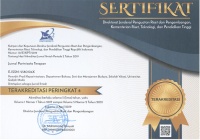Identifying the Potential of Cultural Events as A Reinforce of Tourism Identity on Sibandang Island
Nukeu Novia Andriani(1*), Aji Prasetya Hadi(2)
(1) Politeknik Wilmar Bisnis Indonesia
(2) Politeknik Wilmar Bisnis Indonesia
(*) Corresponding Author
Abstract
Tourism destination development is a crucial program in supporting government efforts to strengthen the tourism sector. In addition to climate and scenery, which serve as primary assets, maximizing cultural and historical attributes, as well as organizing special events, is essential for destination development. Pulau Sibandang, with its unique geological structure and landscape, represents natural heritage and the geological evolution of the Toba eruption, along with its tangible and intangible cultural diversity.
Strengthening the identity of the destination is key, as based on the Tourist Area Life Cycle (TALC) model, Pulau Sibandang is still in the exploration phase of tourism development. This early phase involves natural and cultural attractions that have yet to be fully maximized. Cultural event organization can be a powerful tool to attract tourists and build the destination’s reputation.
This study employs the ADO-ODTWA (Analisis Operasi Objek dan Daya Tarik Wisata Alam) method to analyze the operational aspects of natural tourism attractions. The findings reveal that, while Pulau Sibandang has significant cultural and natural attractions, there are areas needing improvement, particularly accommodation and marketing. Recommendations include integrating community participation in event planning and enhancing infrastructure to better support tourism. The study identifies the potential for cultural event-based festivals and provides a prototype design for such events in Pulau Sibandang, Muara District, North Tapanuli Regency.
Keywords
References
Andriani, N. N., & Hadi, A. P. (2018). Pola Perjalanan Wisatawan Timur Tengah Berdasarkan Profil Wisatawan dan Motivasi Pola Pergerakan di Bandung. National Conference of Creative Industry: Sustainable Tourism Industry for Economic Development, 265–284.
Butler, R. W. (1980). The concept of a tourist area cycle of evolution: Implications for management of resources. Canadian Geographer, 24(1), 5-12. Dolnicar, S. (2020). Market segmentation for tourism: One step further. Journal of Travel Research, 59(6), 1034-1039.
Getz, D. (2008). Event tourism: Definition, evolution, and research. Tourism Management, 29(3), 403-428.
Inskeep, E. (1991). Tourism planning: An integrated and sustainable development approach.
Van Nostrand Reinhold. Jamrozy, U. (2007). Marketing of tourism: A paradigm shift toward sustainability. International Journal of Culture, Tourism and Hospitality Research, 1(2), 117-130.
Kotler, P. (1997). Marketing management: Analysis, planning, implementation, and control (9th ed.). Prentice Hall.
Parasuraman, A., Zeithaml, V. A., & Berry, L. L. (1985). A conceptual model of service quality and its implications for future research. Journal of Marketing, 49(4), 41-50.
Richards, G., & Hall, D. (2000). Tourism and sustainable community development.
Routledge. Schultz, D. E., Tannenbaum, S. I., & Lauterborn, R. F. (1993). Integrated marketing communications: Pulling it together and making it work. NTC Business Books.
Suwarno, A., et al. (2018). Sustainable tourism development in coastal areas: Managing visitor numbers and environmental balance. Journal of Sustainable Tourism, 26(9), 1402-1419.
Tarlow, P. (2009). Tourism safety and security: Practical measures for destinations. Butterworth-Heinemann.
Article Metrics
Refbacks
Copyright (c) 2024 Nukeu Novia Andriani, Aji Prasetya Hadi

This work is licensed under a Creative Commons Attribution-ShareAlike 4.0 International License.













